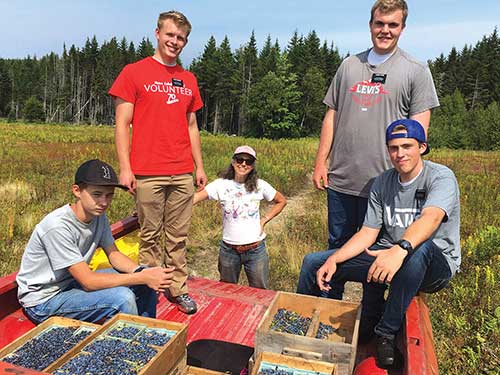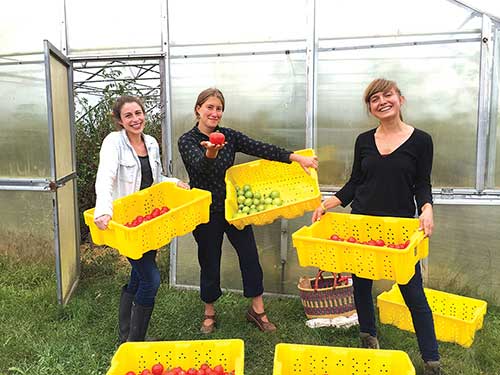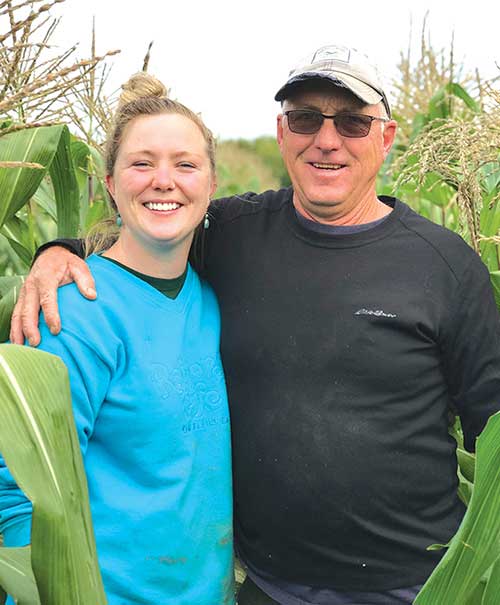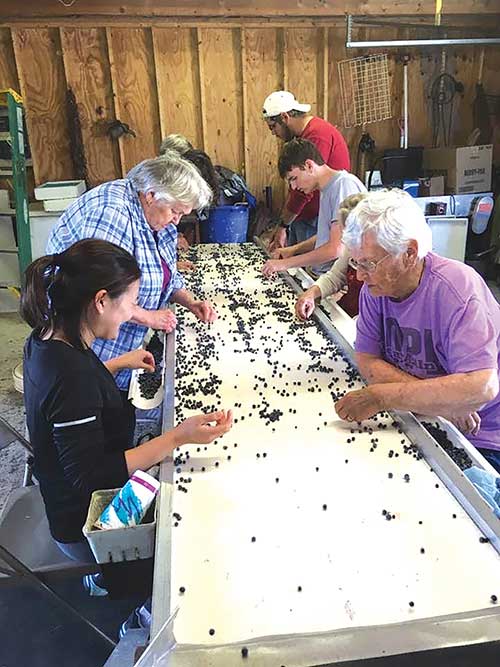 |
| Regina Grabrovac and four young missionary volunteers from the Church of the Latter Day Saints harvest blueberries. Photo courtesy of Regina Grabrovac |
 |
| Volunteers glean what’s left of the tomato crop at Blue-Zee Farm in Penobscot. From left to right: Elise Teixido, Anna Wind and Justine Appel. Photo by Rachel Emus |
 |
| Lydia Brown and he dad, Buster, farm together in Lincoln County. The Browns donated over 5,000 pounds of produce last year, and they graciously welcomed large volunteer groups to glean. Photo by Sally Ingraham |
 |
| Students from the Bowdoin College McKeen Center for the Common Good sort blueberries with women who have done this job for years. Photo by Regina Grabrovac |
By Tim King
A network of farms and gleaner-volunteers, along with food security organizations, has risen up across Maine in an effort to meet the needs of food insecure Maine residents. From Aroostook County in the north to Lincoln and Cumberland counties in the south, farmers are teaming up with nonprofit organizations and social service agencies, along with hundreds of volunteers, to rescue good food and distribute it through a variety of ingenious ways.
Healthy Acadia in Washington County
In Washington County the nonprofit Healthy Acadia works with a few blueberry farmers to glean blueberries that the farmers might never harvest.
“I had wanted to do a blueberry glean for a few years prior, but was concerned about the logistics of a highly perishable product,” says Regina Grabrovac, a food programs manager for Healthy Acadia in Washington County. “What pushed me over the edge was the wholesale market situation for wild blueberries. Processors were indicating that the price that they were going to be paying the growers, beginning around 2015, was declining due to an oversupply of berries on the world market.”
Blueberries, after they’ve been raked and harvested, need to be sorted and cleaned before they are presentable. Because of that, Grabrovac knew she had to find not only a farmer with an available field but cleaning equipment as well.
“I had to find a farmer who had a fresh pack processing line, and there aren’t many of these,” she says. “The few that there are are very precious to the owners, and not everybody is willing to let you use their machine, but I found a very generous farmer. They had a couple of fields that they weren’t harvesting because it was not worth it to them.”
A successful gleaning project has a lot of working parts that need to mesh. In the case of the blueberry project, Grabrovac had a farmer with processing equipment, but she needed volunteers. A cadre of community volunteers is vital to Healthy Acadia’s gleaning efforts in Washington County. But when the McKeen Center for the Common Good of Bowdoin College – located in Cumberland County – reached out to Healthy Acadia, Grabrovac knew blueberry gleaning would be perfect for the Bowdoin students’ Community Immersion Orientation Trip.
Grabrovac sees participation in blueberry gleaning as an opportunity to educate the students as well as to rescue blueberries.
“We typically have two days of blueberry gleaning,” she says. “One day with the Bowdoin students and another with community volunteers. For the students it’s an introduction to Maine, so I provide information on how wild blueberries grow, how they are processed, and what small-scale growers in our communities are facing.”
Then the students learn how to harvest blueberries.
“We use hand-held rakes,” she says. She explains the process: “Wild blueberry plants are only 6 to 9 inches high, so bend at the knees, be aware of your back, and use a gentle but firm sweeping motion as you run the rake, held in one hand, through the berries. Take care to not squish them as you rake. Empty your full rake into the 20-pound boxes and repeat. It is a whole-body motion and one that multiple generations of families are familiar with here in Washington County. You learn as you go, and you quickly learn that wasted motion is lost earnings. Good rakers can do 100 to 150 boxes a day.”
After the students finish raking in the morning, they go to the processing line for the afternoon. The line has been operating all morning, preparing berries for the fresh market.
“I really like it when the volunteer gleaners interact with the women whose job is to clean the berries,” Grabrovac says. “These women have been doing this all their lives, and the young volunteers learn a lot from them.”
Like any farming enterprise, the final piece of a successful gleaning project is to get the harvest to market. And, like any marketing effort, this requires planning and good connections.
“I alert the food pantries in the county a week prior to the glean with an estimated date of availability,” Grabrovac says. “As a highly perishable crop, I want the berries in the cooler as soon as possible and moved into the hands of food pantry customers within three to five days. Pantry volunteers and managers come to our Healthy Acadia Coolbot walk-in cooler for pickup.”
For a gleaning project like the blueberry one to succeed, Grabrovac believes that Healthy Acadia has to offer something to the farmer.
“Sometimes I ask a farmer, ‘What do you need help with,’ and they might say they need help derocking a field or harvesting some carrots or that they have a massive weeding project,” she says. “I try to provide that support based on the volunteers that I have available.”
Healthy Acadia in Hancock County
Grabrovac’s Healthy Acadia colleagues in Hancock County work to provide that same sort of support for their farmer-partners. Gleaning is not intended to be a one-way extraction process from the farm, say Katie Freedman and Rachel Emus of Healthy Acadia.
“A good example of how that works is there have been some farms that were hesitant about having volunteers come at harvest time,” the women say. “But they were interested in getting help picking rocks in a field they were getting ready for production. So we organized volunteers to help with that or some other project requiring a lot of labor. Labor is a big issue for a lot of these farms because there’s not many people that want to work on farms in our area.”
However, Anna Davis, a manager at MOFGA-certified organic Beech Hill Farm in Mount Desert in Hancock County, is happy to have Healthy Acadia bring volunteers onto the farm during the harvest. In fact, she sees Emus and those volunteers as an important part of the harvest team. Davis is in regular contact with Emus during the harvest, and they talk about what Emus and her volunteers can do.
“We don’t have to do anything [to organize the volunteers], and that’s great because we don’t have any labor to spare in August,” Davis says. “Emus is punctual, reliable and accessible in August, and she knows where all the fields are. If we need a chard bed clear-cut before replanting, she just drives right in and goes to it.”
The major market for Beech Hill Farm, which is part of College of the Atlantic, is its on-farm stand, which is open Tuesday through Saturday. Harvest crews pick for the Saturday market on Friday. Knowing that Emus will rescue the surplus, harvesters pick plenty to keep the stand shelves full through the close of the market.
“On Saturday we pack everything that’s left and put it in the cooler, and on Monday Emus knows that what’s in the cooler is for gleaning,” says Davis. “She’s really organized. She has her own crates and she weighs it all, so we get an idea how much there is.”
Davis says that she’s worked at a couple of other farms that were committed to supplying surplus produce to food pantries. However, because of time and labor constraints, the farms’ ability to act on that commitment was often limited.
“We want to get our surplus produce to food insecure people in the area, but we don’t have the labor to do that,” Davis says. “Ethically we really believe that’s important, so it’s great that Healthy Acadia serves as a broker between us and the food pantry or other organizations.”
Bar Harbor Farm, not far from Beech Hill, donated 1,700 pounds of mixed produce to Healthy Acadia in 2019 and will work with the organization in 2020.
“Rachel Emus has been doing a great job picking up produce in a reliable way and delivering it to those in need,” Glenon Friedmann of Bar Harbor Farm says. “We strongly support that.”
Friedmann adds that in an ideal world, she’d change things, however.
“Food insecurity in this country is a disgraceful, complex and systemic issue,” she says. “Small farmers, working with thin profit margins, generally want to do their best to help with this problem. Gleaning, in our case, has cost us a bit of labor, harvesting and packing the vegetables, that later end up in the cooler for the gleaning pick-up. A small stipend to offset farm labor and operational expenses, incorporated into the grant paying for the gleaning operation, would be helpful as we do our best to maintain fair wages for our employees.”
Healthy Acadia gleaned 28,042 pounds of produce from 40 farms in 2019 and delivered that quality surplus food to food pantries, free meal programs and other food security organizations.
Lincoln County Gleaners
The Lincoln County Gleaners, part of Healthy Lincoln County, have a different approach to getting food to food-insecure people. They had gleaned just shy of 10,000 pounds of food by the end of the 2019 growing season and distributed it through what they call sharing tables. They generally don’t distribute via food pantries.
“Our goal is to reach the people that are not comfortable visiting food pantries,” says Sally Ingraham of the Lincoln County Gleaners. “We want to expand the charitable food system to include places that are not already being served by other food initiatives. Many times people may just need help one time or they may want to try an unfamiliar vegetable, but don’t want to spend the money for fear of wasting it. We want to encourage everyone to be comfortable, for whatever their reason, to dig in and eat healthy.”
Some of the sharing table sites include the Central Lincoln County YMCA, Healthy Lincoln County, Young’uns of Damariscotta, The Jefferson Scoop, local Head Start facilities and preschools, local libraries and low-income housing. The sharing tables are responding to a definite need in Lincoln County.
Stacey Cole of the Addiction Resource Center in Damariscotta wrote to Ingraham, “Just wanted to touch base and let you know what a positive impact your program has had on our clients. We have received many positive comments from our clients. Having the opportunity to offer a variety of fresh fruits and vegetables to our clients when they otherwise may not be able to get to a farmers’ market or grocery store has been invaluable. The impact of healthy foods during early recovery is vital for functioning, and your program has enabled us to help support our clients’ recovery efforts in a way we haven’t been able to do in the past.”
Last November the Lincoln County Gleaners received a call that allowed them to add to their services. The caller, who leased land to a farmer, said that some pumpkins were available. Did the gleaners want them? They did. The team harvested them, and then a crew processed and froze the pumpkin in a local cooperative kitchen.
“We will absolutely do more processing in the future,” Ingraham says. “It’s fun and another way to capture the local food and make it last the entire year. It is important to eat local food that is available, and processing is one way to make sure the food is utilized and not wasted.”
The Lincoln County Gleaners, along with Healthy Acadia, is a member of the Maine Gleaning Network,which also includes the Western Waldo County Gleaners, Androscoggin Gleaners, Cumberland County Gleaning Initiative, the Merrymeeting Gleaners and UMaine Cooperative Extension, among others. The Gleaning Network organized the successful “Maine Gleaning Week 2019” last October, among other projects.
Partnerships and collaboration are the keys to effective gleaning efforts and to getting nutritious food to those who are food insecure, according to Freedman and Emus of Healthy Acadia. In fact it was a partnership with UMaine Cooperative Extension that got Healthy Acadia into gleaning.
“This started with Cooperative Extension when we were doing an annual apple gleaning with them in a pick-your-own orchard,” Freedman says. “They also have a project where they encourage home gardeners to grow an extra row of vegetables for food pantries, and they help connect people to local pantries. It’s not really gleaning, but it was out of that program and the apple gleaning that the larger gleaning program rose.”
Freedman suggests that the best way to start a local or county-wide gleaning effort is to have the food pantries and other organizations get together to talk and discover mutual needs and interests. The result of forming such a network can include not only creating a gleaning program but, more broadly, moving closer to making our communities food secure.
About the author: Tim King is a produce and sheep farmer, a journalist, and co-founder of a bilingual community newsletter. He lives near Long Prairie, Minnesota.
